Health Promotion and Public Health: Planning and Implementation Report
VerifiedAdded on 2023/06/10
|6
|1475
|449
Report
AI Summary
This report provides a comprehensive overview of planning and implementation strategies in health promotion and public health. It delves into the significance of structured planning, outlining the steps involved in developing effective health programs. The report explores various planning and implementation models, such as the Precede-Proceed model, and their role in disease reduction. It also identifies key stakeholders, including policymakers, implementers, partners, and beneficiaries, and their contributions to project success. The importance of quality assurance models, like Donabedian and Maxwell, is discussed to ensure high-quality healthcare practices. Furthermore, the report highlights the significance of commissioning in public health, emphasizing cost-effective healthcare delivery through planning, acquisition, performance review, and public enrollment. The role of good communication and teamwork within healthcare teams is also underscored as crucial for program success, leading to improved health outcomes. The report concludes by summarizing the importance of planning, stakeholder involvement, quality maintenance, commissioning, communication, and teamwork in achieving successful public health initiatives.
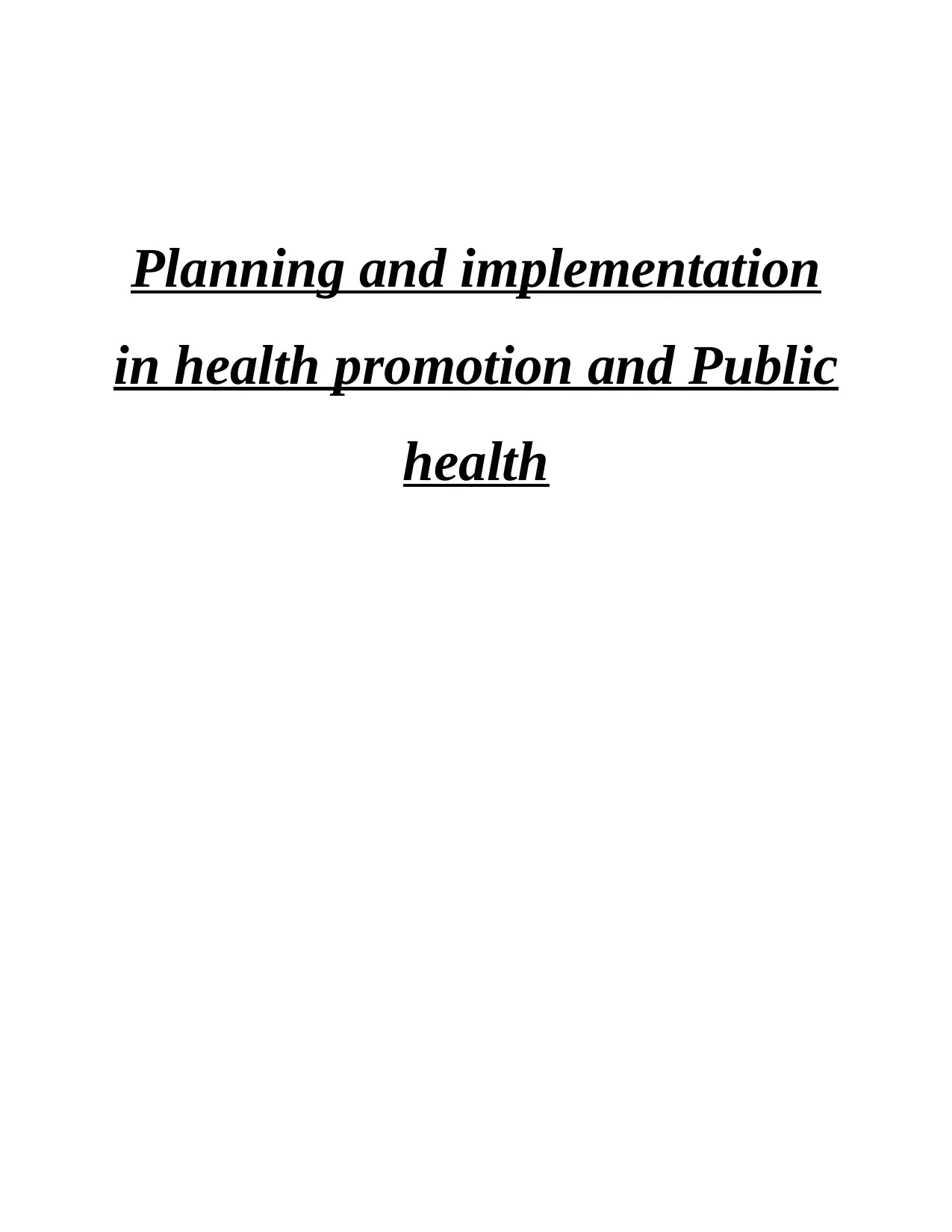
Planning and implementation
in health promotion and Public
health
in health promotion and Public
health
Paraphrase This Document
Need a fresh take? Get an instant paraphrase of this document with our AI Paraphraser
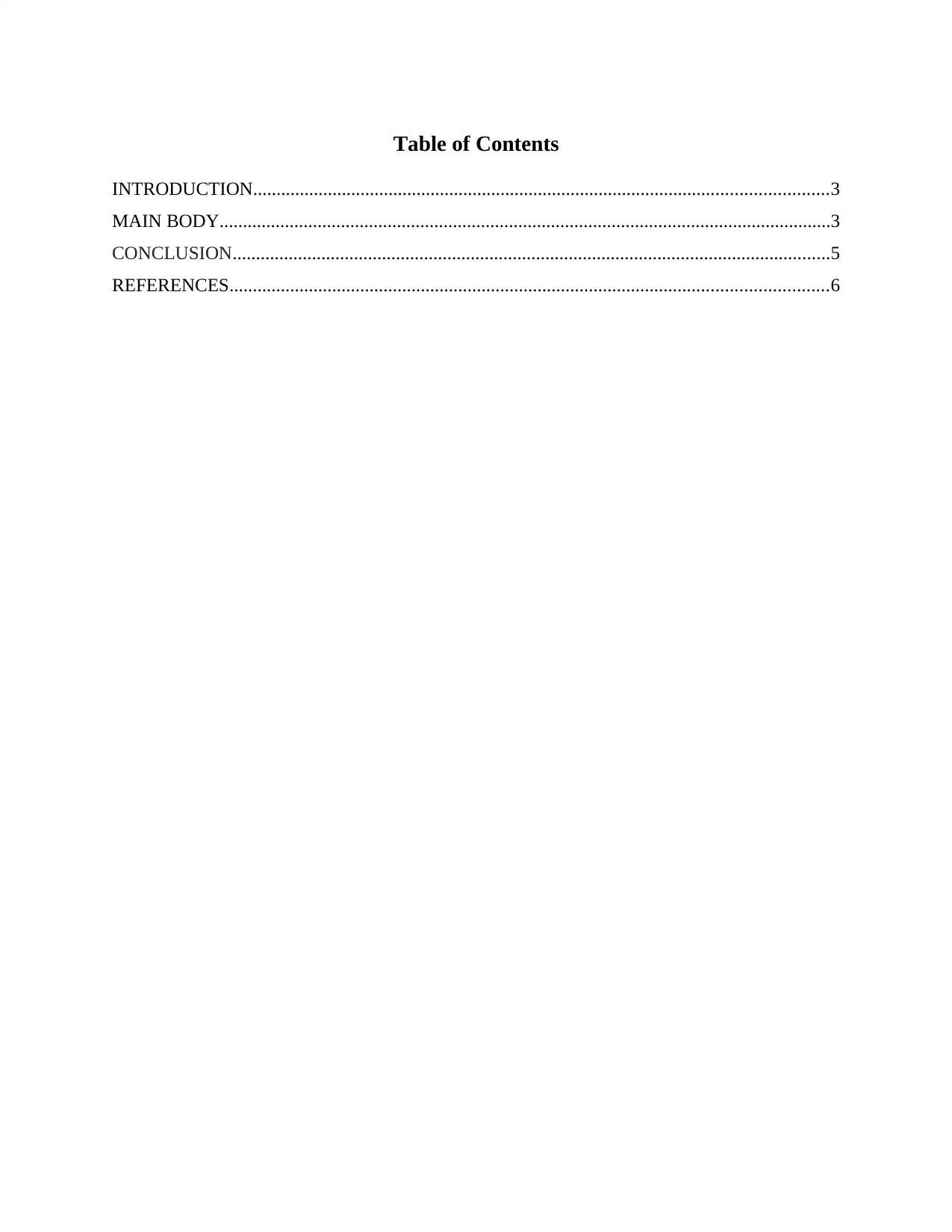
Table of Contents
INTRODUCTION...........................................................................................................................3
MAIN BODY...................................................................................................................................3
CONCLUSION................................................................................................................................5
REFERENCES................................................................................................................................6
INTRODUCTION...........................................................................................................................3
MAIN BODY...................................................................................................................................3
CONCLUSION................................................................................................................................5
REFERENCES................................................................................................................................6
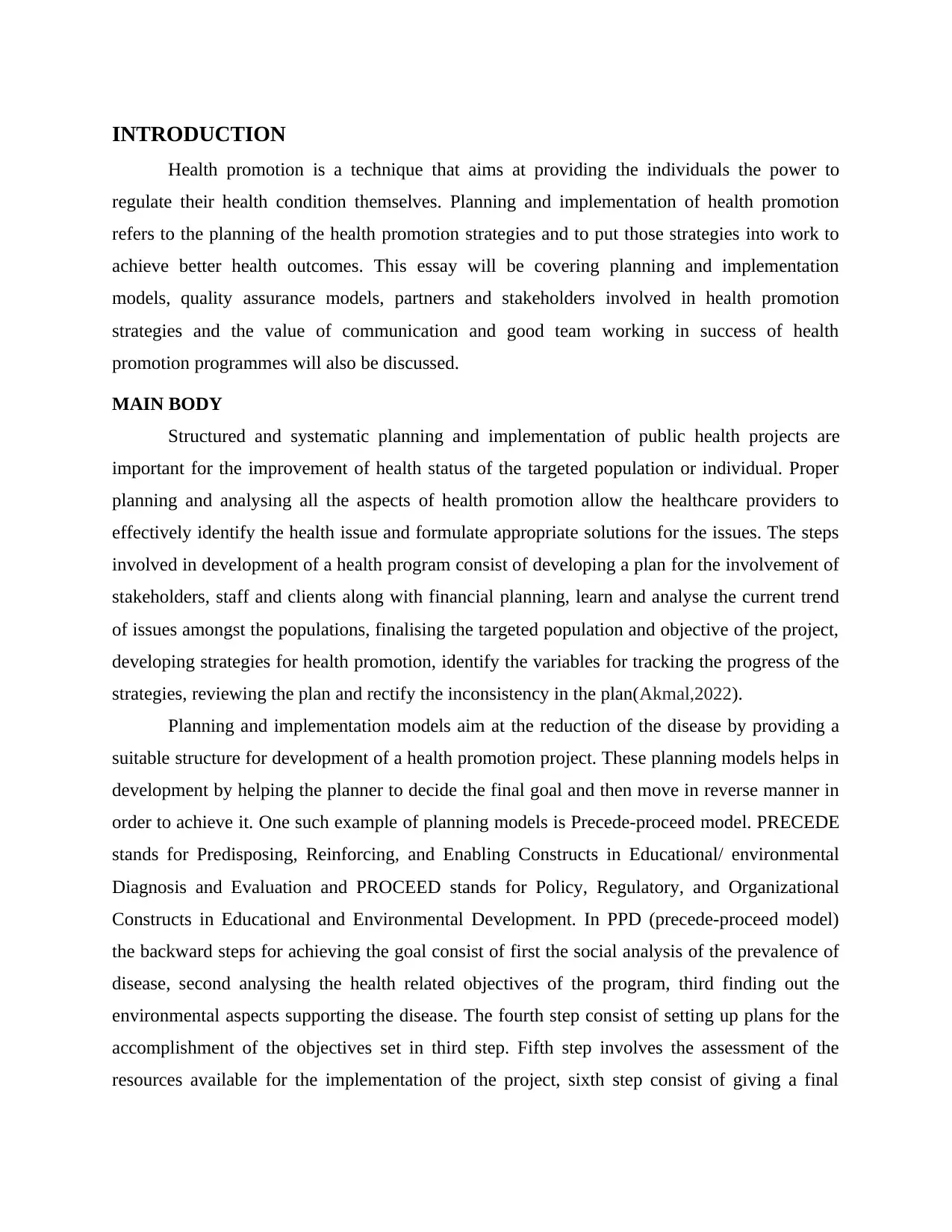
INTRODUCTION
Health promotion is a technique that aims at providing the individuals the power to
regulate their health condition themselves. Planning and implementation of health promotion
refers to the planning of the health promotion strategies and to put those strategies into work to
achieve better health outcomes. This essay will be covering planning and implementation
models, quality assurance models, partners and stakeholders involved in health promotion
strategies and the value of communication and good team working in success of health
promotion programmes will also be discussed.
MAIN BODY
Structured and systematic planning and implementation of public health projects are
important for the improvement of health status of the targeted population or individual. Proper
planning and analysing all the aspects of health promotion allow the healthcare providers to
effectively identify the health issue and formulate appropriate solutions for the issues. The steps
involved in development of a health program consist of developing a plan for the involvement of
stakeholders, staff and clients along with financial planning, learn and analyse the current trend
of issues amongst the populations, finalising the targeted population and objective of the project,
developing strategies for health promotion, identify the variables for tracking the progress of the
strategies, reviewing the plan and rectify the inconsistency in the plan(Akmal,2022).
Planning and implementation models aim at the reduction of the disease by providing a
suitable structure for development of a health promotion project. These planning models helps in
development by helping the planner to decide the final goal and then move in reverse manner in
order to achieve it. One such example of planning models is Precede-proceed model. PRECEDE
stands for Predisposing, Reinforcing, and Enabling Constructs in Educational/ environmental
Diagnosis and Evaluation and PROCEED stands for Policy, Regulatory, and Organizational
Constructs in Educational and Environmental Development. In PPD (precede-proceed model)
the backward steps for achieving the goal consist of first the social analysis of the prevalence of
disease, second analysing the health related objectives of the program, third finding out the
environmental aspects supporting the disease. The fourth step consist of setting up plans for the
accomplishment of the objectives set in third step. Fifth step involves the assessment of the
resources available for the implementation of the project, sixth step consist of giving a final
Health promotion is a technique that aims at providing the individuals the power to
regulate their health condition themselves. Planning and implementation of health promotion
refers to the planning of the health promotion strategies and to put those strategies into work to
achieve better health outcomes. This essay will be covering planning and implementation
models, quality assurance models, partners and stakeholders involved in health promotion
strategies and the value of communication and good team working in success of health
promotion programmes will also be discussed.
MAIN BODY
Structured and systematic planning and implementation of public health projects are
important for the improvement of health status of the targeted population or individual. Proper
planning and analysing all the aspects of health promotion allow the healthcare providers to
effectively identify the health issue and formulate appropriate solutions for the issues. The steps
involved in development of a health program consist of developing a plan for the involvement of
stakeholders, staff and clients along with financial planning, learn and analyse the current trend
of issues amongst the populations, finalising the targeted population and objective of the project,
developing strategies for health promotion, identify the variables for tracking the progress of the
strategies, reviewing the plan and rectify the inconsistency in the plan(Akmal,2022).
Planning and implementation models aim at the reduction of the disease by providing a
suitable structure for development of a health promotion project. These planning models helps in
development by helping the planner to decide the final goal and then move in reverse manner in
order to achieve it. One such example of planning models is Precede-proceed model. PRECEDE
stands for Predisposing, Reinforcing, and Enabling Constructs in Educational/ environmental
Diagnosis and Evaluation and PROCEED stands for Policy, Regulatory, and Organizational
Constructs in Educational and Environmental Development. In PPD (precede-proceed model)
the backward steps for achieving the goal consist of first the social analysis of the prevalence of
disease, second analysing the health related objectives of the program, third finding out the
environmental aspects supporting the disease. The fourth step consist of setting up plans for the
accomplishment of the objectives set in third step. Fifth step involves the assessment of the
resources available for the implementation of the project, sixth step consist of giving a final
⊘ This is a preview!⊘
Do you want full access?
Subscribe today to unlock all pages.

Trusted by 1+ million students worldwide
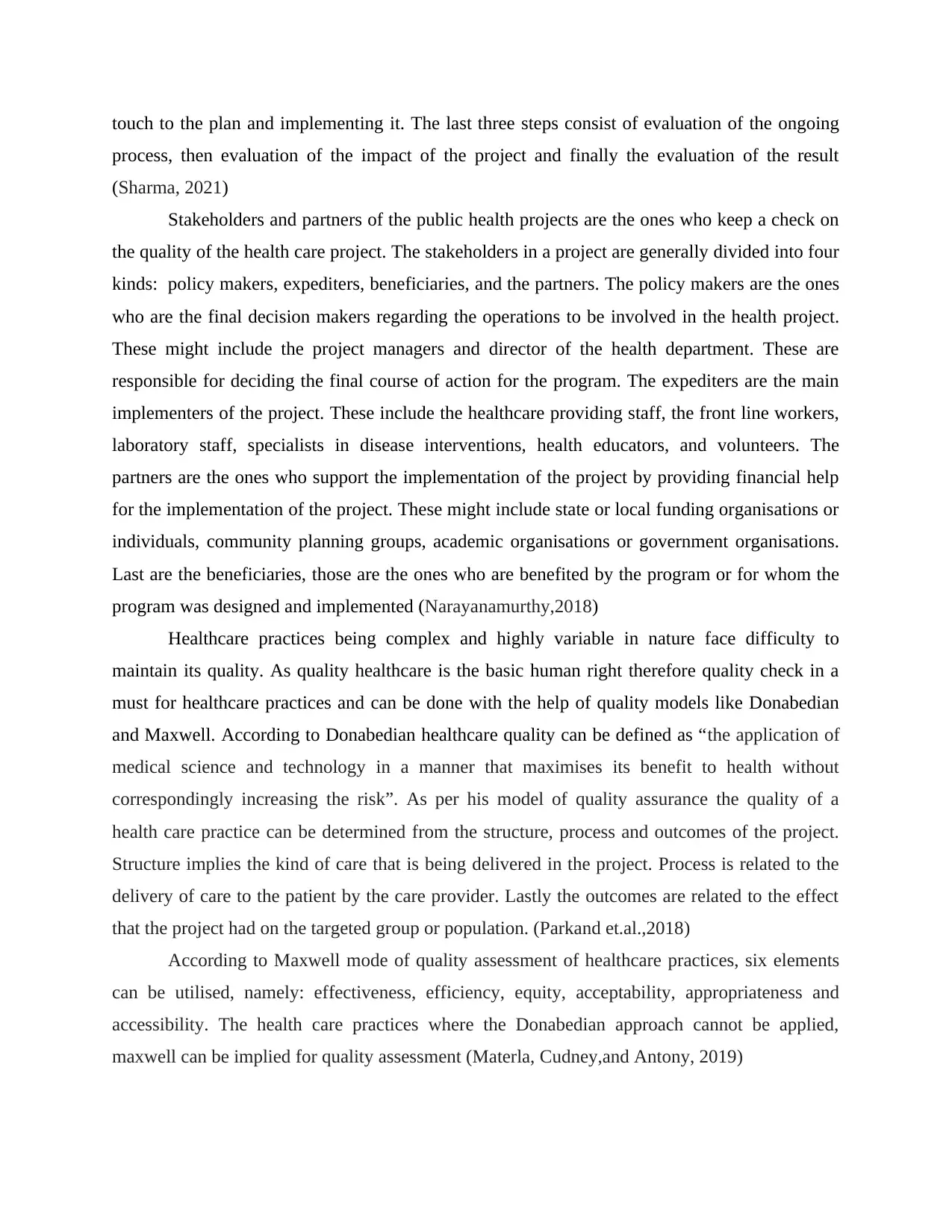
touch to the plan and implementing it. The last three steps consist of evaluation of the ongoing
process, then evaluation of the impact of the project and finally the evaluation of the result
(Sharma, 2021)
Stakeholders and partners of the public health projects are the ones who keep a check on
the quality of the health care project. The stakeholders in a project are generally divided into four
kinds: policy makers, expediters, beneficiaries, and the partners. The policy makers are the ones
who are the final decision makers regarding the operations to be involved in the health project.
These might include the project managers and director of the health department. These are
responsible for deciding the final course of action for the program. The expediters are the main
implementers of the project. These include the healthcare providing staff, the front line workers,
laboratory staff, specialists in disease interventions, health educators, and volunteers. The
partners are the ones who support the implementation of the project by providing financial help
for the implementation of the project. These might include state or local funding organisations or
individuals, community planning groups, academic organisations or government organisations.
Last are the beneficiaries, those are the ones who are benefited by the program or for whom the
program was designed and implemented (Narayanamurthy,2018)
Healthcare practices being complex and highly variable in nature face difficulty to
maintain its quality. As quality healthcare is the basic human right therefore quality check in a
must for healthcare practices and can be done with the help of quality models like Donabedian
and Maxwell. According to Donabedian healthcare quality can be defined as “the application of
medical science and technology in a manner that maximises its benefit to health without
correspondingly increasing the risk”. As per his model of quality assurance the quality of a
health care practice can be determined from the structure, process and outcomes of the project.
Structure implies the kind of care that is being delivered in the project. Process is related to the
delivery of care to the patient by the care provider. Lastly the outcomes are related to the effect
that the project had on the targeted group or population. (Parkand et.al.,2018)
According to Maxwell mode of quality assessment of healthcare practices, six elements
can be utilised, namely: effectiveness, efficiency, equity, acceptability, appropriateness and
accessibility. The health care practices where the Donabedian approach cannot be applied,
maxwell can be implied for quality assessment (Materla, Cudney,and Antony, 2019)
process, then evaluation of the impact of the project and finally the evaluation of the result
(Sharma, 2021)
Stakeholders and partners of the public health projects are the ones who keep a check on
the quality of the health care project. The stakeholders in a project are generally divided into four
kinds: policy makers, expediters, beneficiaries, and the partners. The policy makers are the ones
who are the final decision makers regarding the operations to be involved in the health project.
These might include the project managers and director of the health department. These are
responsible for deciding the final course of action for the program. The expediters are the main
implementers of the project. These include the healthcare providing staff, the front line workers,
laboratory staff, specialists in disease interventions, health educators, and volunteers. The
partners are the ones who support the implementation of the project by providing financial help
for the implementation of the project. These might include state or local funding organisations or
individuals, community planning groups, academic organisations or government organisations.
Last are the beneficiaries, those are the ones who are benefited by the program or for whom the
program was designed and implemented (Narayanamurthy,2018)
Healthcare practices being complex and highly variable in nature face difficulty to
maintain its quality. As quality healthcare is the basic human right therefore quality check in a
must for healthcare practices and can be done with the help of quality models like Donabedian
and Maxwell. According to Donabedian healthcare quality can be defined as “the application of
medical science and technology in a manner that maximises its benefit to health without
correspondingly increasing the risk”. As per his model of quality assurance the quality of a
health care practice can be determined from the structure, process and outcomes of the project.
Structure implies the kind of care that is being delivered in the project. Process is related to the
delivery of care to the patient by the care provider. Lastly the outcomes are related to the effect
that the project had on the targeted group or population. (Parkand et.al.,2018)
According to Maxwell mode of quality assessment of healthcare practices, six elements
can be utilised, namely: effectiveness, efficiency, equity, acceptability, appropriateness and
accessibility. The health care practices where the Donabedian approach cannot be applied,
maxwell can be implied for quality assessment (Materla, Cudney,and Antony, 2019)
Paraphrase This Document
Need a fresh take? Get an instant paraphrase of this document with our AI Paraphraser
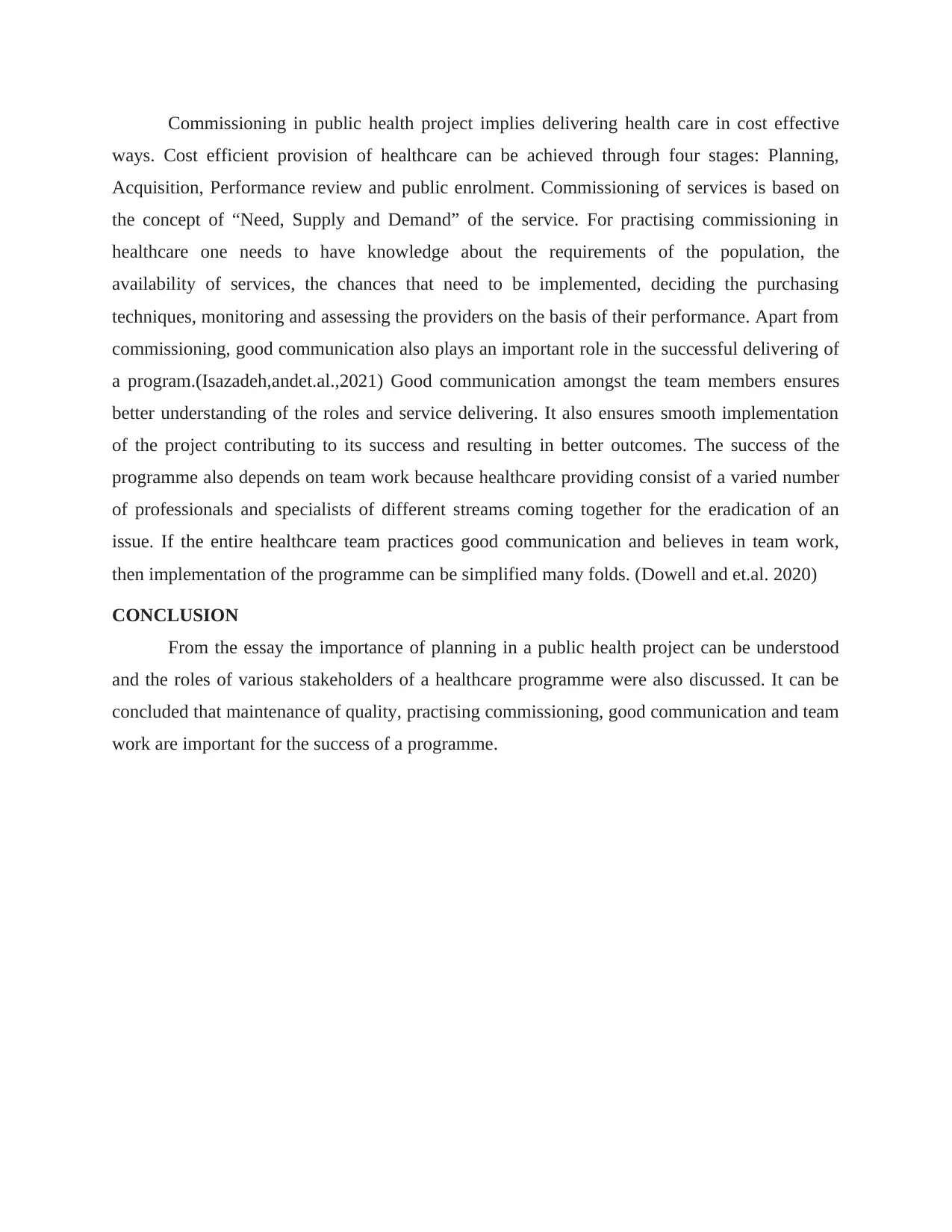
Commissioning in public health project implies delivering health care in cost effective
ways. Cost efficient provision of healthcare can be achieved through four stages: Planning,
Acquisition, Performance review and public enrolment. Commissioning of services is based on
the concept of “Need, Supply and Demand” of the service. For practising commissioning in
healthcare one needs to have knowledge about the requirements of the population, the
availability of services, the chances that need to be implemented, deciding the purchasing
techniques, monitoring and assessing the providers on the basis of their performance. Apart from
commissioning, good communication also plays an important role in the successful delivering of
a program.(Isazadeh,andet.al.,2021) Good communication amongst the team members ensures
better understanding of the roles and service delivering. It also ensures smooth implementation
of the project contributing to its success and resulting in better outcomes. The success of the
programme also depends on team work because healthcare providing consist of a varied number
of professionals and specialists of different streams coming together for the eradication of an
issue. If the entire healthcare team practices good communication and believes in team work,
then implementation of the programme can be simplified many folds. (Dowell and et.al. 2020)
CONCLUSION
From the essay the importance of planning in a public health project can be understood
and the roles of various stakeholders of a healthcare programme were also discussed. It can be
concluded that maintenance of quality, practising commissioning, good communication and team
work are important for the success of a programme.
ways. Cost efficient provision of healthcare can be achieved through four stages: Planning,
Acquisition, Performance review and public enrolment. Commissioning of services is based on
the concept of “Need, Supply and Demand” of the service. For practising commissioning in
healthcare one needs to have knowledge about the requirements of the population, the
availability of services, the chances that need to be implemented, deciding the purchasing
techniques, monitoring and assessing the providers on the basis of their performance. Apart from
commissioning, good communication also plays an important role in the successful delivering of
a program.(Isazadeh,andet.al.,2021) Good communication amongst the team members ensures
better understanding of the roles and service delivering. It also ensures smooth implementation
of the project contributing to its success and resulting in better outcomes. The success of the
programme also depends on team work because healthcare providing consist of a varied number
of professionals and specialists of different streams coming together for the eradication of an
issue. If the entire healthcare team practices good communication and believes in team work,
then implementation of the programme can be simplified many folds. (Dowell and et.al. 2020)
CONCLUSION
From the essay the importance of planning in a public health project can be understood
and the roles of various stakeholders of a healthcare programme were also discussed. It can be
concluded that maintenance of quality, practising commissioning, good communication and team
work are important for the success of a programme.
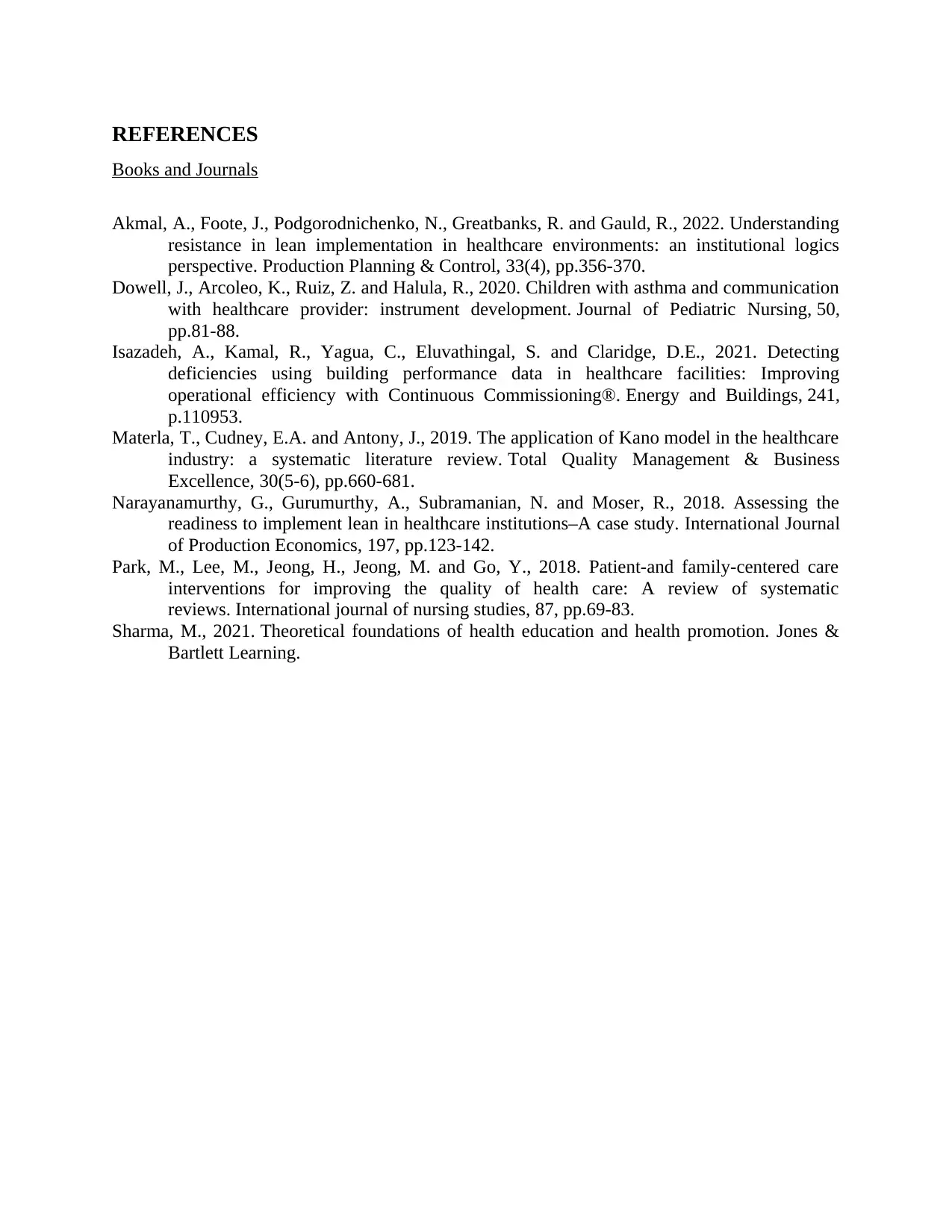
REFERENCES
Books and Journals
Akmal, A., Foote, J., Podgorodnichenko, N., Greatbanks, R. and Gauld, R., 2022. Understanding
resistance in lean implementation in healthcare environments: an institutional logics
perspective. Production Planning & Control, 33(4), pp.356-370.
Dowell, J., Arcoleo, K., Ruiz, Z. and Halula, R., 2020. Children with asthma and communication
with healthcare provider: instrument development. Journal of Pediatric Nursing, 50,
pp.81-88.
Isazadeh, A., Kamal, R., Yagua, C., Eluvathingal, S. and Claridge, D.E., 2021. Detecting
deficiencies using building performance data in healthcare facilities: Improving
operational efficiency with Continuous Commissioning®. Energy and Buildings, 241,
p.110953.
Materla, T., Cudney, E.A. and Antony, J., 2019. The application of Kano model in the healthcare
industry: a systematic literature review. Total Quality Management & Business
Excellence, 30(5-6), pp.660-681.
Narayanamurthy, G., Gurumurthy, A., Subramanian, N. and Moser, R., 2018. Assessing the
readiness to implement lean in healthcare institutions–A case study. International Journal
of Production Economics, 197, pp.123-142.
Park, M., Lee, M., Jeong, H., Jeong, M. and Go, Y., 2018. Patient-and family-centered care
interventions for improving the quality of health care: A review of systematic
reviews. International journal of nursing studies, 87, pp.69-83.
Sharma, M., 2021. Theoretical foundations of health education and health promotion. Jones &
Bartlett Learning.
Books and Journals
Akmal, A., Foote, J., Podgorodnichenko, N., Greatbanks, R. and Gauld, R., 2022. Understanding
resistance in lean implementation in healthcare environments: an institutional logics
perspective. Production Planning & Control, 33(4), pp.356-370.
Dowell, J., Arcoleo, K., Ruiz, Z. and Halula, R., 2020. Children with asthma and communication
with healthcare provider: instrument development. Journal of Pediatric Nursing, 50,
pp.81-88.
Isazadeh, A., Kamal, R., Yagua, C., Eluvathingal, S. and Claridge, D.E., 2021. Detecting
deficiencies using building performance data in healthcare facilities: Improving
operational efficiency with Continuous Commissioning®. Energy and Buildings, 241,
p.110953.
Materla, T., Cudney, E.A. and Antony, J., 2019. The application of Kano model in the healthcare
industry: a systematic literature review. Total Quality Management & Business
Excellence, 30(5-6), pp.660-681.
Narayanamurthy, G., Gurumurthy, A., Subramanian, N. and Moser, R., 2018. Assessing the
readiness to implement lean in healthcare institutions–A case study. International Journal
of Production Economics, 197, pp.123-142.
Park, M., Lee, M., Jeong, H., Jeong, M. and Go, Y., 2018. Patient-and family-centered care
interventions for improving the quality of health care: A review of systematic
reviews. International journal of nursing studies, 87, pp.69-83.
Sharma, M., 2021. Theoretical foundations of health education and health promotion. Jones &
Bartlett Learning.
⊘ This is a preview!⊘
Do you want full access?
Subscribe today to unlock all pages.

Trusted by 1+ million students worldwide
1 out of 6
Related Documents
Your All-in-One AI-Powered Toolkit for Academic Success.
+13062052269
info@desklib.com
Available 24*7 on WhatsApp / Email
![[object Object]](/_next/static/media/star-bottom.7253800d.svg)
Unlock your academic potential
Copyright © 2020–2025 A2Z Services. All Rights Reserved. Developed and managed by ZUCOL.




